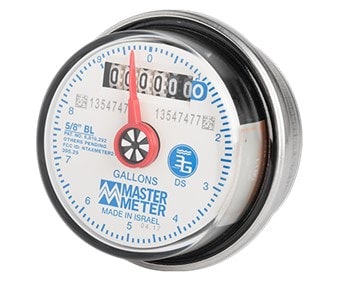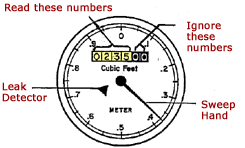Use Your Meter to Find Leaks

We encourage you to occasionally read your meter to double check your bill or to see how much water you have used during a particular period. It can also be used to detect leaks.
FINDING YOUR WATER METER
Your water meter can be found in a plastic or concrete box between your sidewalk and the street. For those homes without sidewalks, the meter box should be at the edge of your property near the street.
UNITS OF MEASURE
Your meter measures water in cubic feet, not in gallons. Each cubic foot is equal to 7.48 gallons. You will notice on your monthly bill that you are billed for "units" of water. One unit equals 100 cubic feet or 748 gallons of water.

READING YOUR METER
Lift the lid of the meter box with your hand or a screwdriver. Inside you will see a large dial with a meter register that resembles a car's odometer. When the hand makes a complete cycle, it measures one cubic foot. One hundred cubic feet, or one unit, equals 748 gallons. The black numbers show tenths and hundredths of units. These numbers are not read during meter reading. The next series of numbers (the white numbers) are the number of units (100 cubic foot increments) that have passed through the meter. These numbers should be compared to your bill to verify accuracy.
To determine the number of units used since the last meter reading, subtract the previous reading from your current meter reading. For example, the illustration to the right shows a meter reading of 235 units of water. If we use a previous reading of 200, we can see that 35 units of water have been used since the last meter reading.
VERIFYING YOUR MONTHLY BILL
District employees electronically read your meter about the same time each month (around the 15th of the month). The date your meter was read can be found in the upper left hand corner of your bill. Directly below that date is the meter reading for the month. The PRIOR READ is the reading from the previous month, CURRENT READ is the reading for the current month, USAGE-100 CU. FT. is the number of units, AMOUNT is the dollar amount charged for the water used. Read your meter on the day you receive your bill. Depending on your monthly water use, the read should be within a few units of the CURRENT READ. If not, contact the District to have it checked out.
USING YOUR METER TO FIND LEAKS
Make sure all faucets are turned off inside and outside the home. Read the meter and mark the position of the sweep hand with a piece of tape. Do not use any water for 30 minutes. Read the meter again. If the reading has changed, you have a leak. If the read has not changed but the leak detector arrow is moving, you have a minor leak that is registering less than 1/200 of a gallon per hour. Leaks registered by your meter are the responsibility of the homeowner. VVCSD does not repair leaks on your side of the meter.
To locate the leak, verify all the water is still off and turn off the water to the house at the house valve. Mark the position of the sweep hand again. Do not use any water for another 30 minutes. Read the meter again. If the reading has changed or the leak detector arrow is moving, you have a leak in your front yard. If the reading did not change and the leak detector arrow is not moving, the leak is somewhere in your house or backyard.
To check for toilet leaks, add a few drops of food coloring (or dye tablets are available at the District office) in the tank and wait 30 minutes; if the water in the bowl has changed color, you have a leak in the flush mechanism. This is easily repaired with parts from a hardware store.
